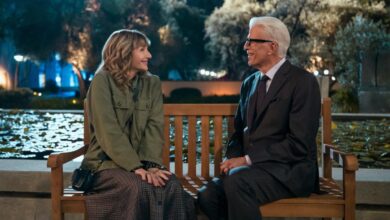How Come Sharon Stone’s Leading Lady Career Never Quite Made It Out Of The ’90s?
The Nobody movies starring Bob Odenkirk aren’t the full-on action all-stars of their cousins in the John Wick movies, nor are they full-on nostalgia fests like an Expendables movie. But they do homage to the value of a familiar face allowed to go over the top: The first movie brought out everyone’s favorite avuncular ’80s-movie lunatic Christopher Lloyd to play Odenkirk’s father, and he returns for the new sequel, which also brings in an even bigger star as the movie’s primary villain. Yes, that’s Sharon Stone going absolutely nuts as the dog-toting, henchmen-murdering, easily-bored queenpin Lendina, the movie’s imposing and self-impressed final boss.
It’s great to see Stone again, something that’s barely undercut by the fact that, objectively speaking, her performance is pretty terrible. It’s clearly meant to go over-the-top, and on that level it does succeed. But it doesn’t much fit the tone of the Nobody movies, which are certainly silly and outlandish, but tend to derive more humor from their deadpan treatment of regular-guy-is-a-secret-badass material, and anchor themselves in the surprising believability of Odenkirk’s performance. He’s so good, in fact, that he only draws attention to how self-conscious Stone is, laboring to play such a fierce diva, as if she can’t stop thinking about whether she’s doing an iconic enough job to warrant drag-queen imitation down the line. That’s just a guess, but something must be distracting her; some of her half-formed line-readings suggest that she first saw the dialogue mere minutes before shooting.
Lendina is winkingly first introduced in a casino scene (and one with a pretty nonsensical kill-em-all button, to boot), bringing to mind what may be Stone’s greatest triumph: Her Oscar-nominated turn as Ginger, the reluctant wife of Robert De Niro’s Ace in the Martin Scorsese crime drama Casino. This year marks the 30th anniversary of Casino, as well as arguably the second-best movie Stone ever starred in: The Quick and the Dead, Sam Raimi’s underseen 1995 Western. Yes, of course Stone’s most iconic and career-making performance came with 1992’s Basic Instinct. But a year where she starred as a female gunslinger and got Oscar attention for a Scorsese picture seems like an inarguable highlight.

Indeed, it remains that way 30 years on, in part because Stone’s leading-lady career didn’t ever really make it outside of the ’90s. Some of this can be blamed on Hollywood ageism; Stone was 34 when Basic Instinct hit, having paid her dues for a decade before she became a household name, and over the dreaded 40 by the decade’s end, subject to variations on the same shabby treatment received by other ’90s actresses as varied as Demi Moore, Meg Ryan, and Winona Ryder. She also suffered a subarachnoid hemorrhage in 2001, which led to an inopportune break from acting before jumping back in for the mid-2000s – and already, by 2004, taking the kind of campy villainess role she plays in Nobody 2. Opposite Halle Berry in Catwoman, no one emerged looking great – but Berry still had plenty of sex-symbol time to reset her career. After Stone’s belated Basic Instinct 2 flopped even harder in 2006, she stepped back to obscurities and/or character parts.
Despite those bad breaks, there’s also something that feels particularly ’90s about Stone. At the time, she seemed like a throwback to noirish bombshells of multiple different eras, like Gloria Grahame from the 1950s and Kathleen Turner from the 1980s, suggesting a certain timelessness to her appeal. But like Demi Moore, Stone maintained a sharp edge that made her a great antidote to ’90s rom-com queens; unlike Moore, her filmography skewed toward cheese like The Specialist, opposite Sylvester Stallone, or Sliver, her voyeurism-obsessed Basic Instinct follow-up with Billy Baldwin. She had the vision to advocate for casting both Russell Crowe and Leonardo DiCaprio in The Quick and the Dead, only to see them inhabit their characters so well that her laconic Eastwoodian gunslinger looked all the more like a pose. Her work in Casino is so effective in part because Ginger doesn’t conceal hidden depths. Her glamor is her stock in trade, her marriage more or less a gig that she can’t get out of fast enough. It’s a ferocious performance, maybe her best, but not exactly a multifaceted one.
Notably, 1995 also saw the premiere of Catwalk, a fashion-industry documentary that marked Stone’s first doc appearance – of many, as it turns out. She’s credited in around 20 documentaries over the past 30 years, sometimes for archival footage (again, that Basic Instinct era is iconic) but more often for actual appearances in nonfiction films about celebrities, fashion, and mindfulness, among other topics. There’s nothing wrong with Stone enthusiastically speaking about this stuff; she even turned her frequent doc appearances into a bit of performance art with the Rolling Thunder Revue documentary, where she reunited with Martin Scorsese to give details of her time as a young woman, following Bob Dylan around on tour – accounts that were, in keeping with the documentary’s carnival-trick style, entirely fabricated.

Depending on your patience levels, this kind of trickery could be delightful or insufferable. But either way, it feels like Stone’s most notable performance of the past decade, trading on one image of her (the ’90s femme fatale); mixing in a phony, unseen other side (the young aspiring actress on a devil-may-care adventure); and playing it all off in a way that raises the slightest hint of suspicion. She feels more at home putting forth a fake version of herself; her fakeness in Nobody 2, meanwhile, is both overworked and underwritten. It’s true enough that Hollywood no longer makes many of the types of movies that Stone once specialized in. It’s also arguable that those movies made Stone too self-aware to keep starring in them.
Jesse Hassenger (@rockmarooned) is a writer living in Brooklyn. He’s a regular contributor to The A.V. Club, Polygon, and The Week, among others. He podcasts at www.sportsalcohol.com, too.
Credit to Nypost AND Peoples



